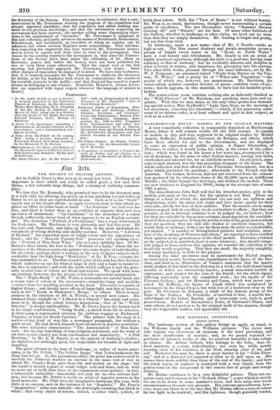THE NATIONAL INSTITUTION.
SECOND NOTICE.
The landscape section of this gallery brings us again, as usual, to the Williams family and the Williams pictures. The clever man who repeats one cleverness ad nauseam is the most provoking and the most insufferable of mortals; and, as we passed repeated re- petitions of talented works of old, we resolved inwardly to take refuge in silence. Mr. Arthur Gilbert, who belongs to the tribe, does in- deed maintain a certain individuality ; yet even he, while mostly steering clear of his relatives, is far from steering clear of his past self. However this may be, there is great beauty in his "Calm Even- ing," and of a kind not yet repeated so often as to pall upon us. His masses have more solidity than those of the rest of the family ; and here the warm repose of summer is conveyed with a true charm, from the golden tones of the foreground to the remote line of purple and orange distance.
Mr. Hulme continues to be a very delightful painter. There are ex- quisite taste and freshness in his " Newark Abbey"; a spot which is exactly the one to lie down in some summer's noon, and doze away into warm unconsciousness through very pleasure. His extreme agreeableness, how- ever, must not blind us to the fact that Mr. Hulme affects a tone of colour far too light to be truthful; and this lightness, though generally tender,
is sometimes violent, as in "The Lazy Herd; a scene on the Conway." The cattle here are by Mr. Willis; to whom we have only to reiterate our commendations of last year, qualified by the same caution against bright- ness without depth of colour which we address to Mr. Hulme. An Edin- burgh artist, Mr. Edward Hargitt, who had not, we think, before ex- hibited in London, sends a number of small views which excite notice. All are distinguished by simplicity of material and treatment, much na- tural truth of aspect obtained with ease and freedom, and a style which, without elaboration, is not loose. The subjects have variety and interest. The "Barley-field," depicted under a shower, is a capital example. The elegant rusticity of Mr. Peel, and the glowing brilliant colour of Mr. Holland, are well represented. Mr. John Bell, whom we have heard spoken of as a self-taught genius, shows improved Dower of painting in "Midsummer Evening at Conway," which is a kind ofOssianic railway picture : in "The Traveller," a would-be "classic composition" he flounders piteously amid the Old clothes of conventional untruth, which he cannot manage so as even to tell his lie decently. Let us hope he will never commit such a blunder again. We cannot account for the com- mon washy manner of Mr. Dawson's "Boat passing a Lock on the Ere- wash Canal, Derbyshire" ; his "Old Mill at Bishopstoke," though a slight affair, is in his own style.
Mr. Prom's interiors are always extremely skilful and attractive. Of the two from "A Breton Farm, St. Pol de Leon," No. 275 is the better. Mr. William Poole suffers from the disadvantage of dull leaden colour and want of interest ; but his renderings are faithful, and show a capacity for drawing. Mr. Herring sends some of his most dexterous animal pieces; Mr. Earl, with scarcely inferior facility of hand in the same style, displays more character.
It is seldom, in a collection like this, that one has to look to the sub- ordinate department of water-colours for the best landscape : but such is the case in the present instance. "Anster Cove, South Devon," by Mr. Boyce, is a study where everything is felt and rendered with that single- hearted reliance on nature which is the test of a true vocation, the assu- rance of honest work, and the induction to all highest excellence to come. Nothing is forced, nothing neglected ; it is all simple, true, and hearty. The shallow inlet of beach between cliffs sloping green and purple almost to the sea's margin, the little space of pure verdure which lies between them in inviting repose, and the sky streaked with faint brushes of cloud, are nature unadulterated. The shade over the sea is a difficult and beau- tiful passage admirably rendered ; and the water itself, though not quite so unexceptionable as a matter of imitation is perfectly felt. This ittle
picture is equally good and delightful. " i iabbicombe Bay," by the same artist, has more material portrayed with similar care, but less effect of completeness. The general result is rather scattered and spotty, and the sky cold ; still, the impression is very true ; and, after one has looked for a minute or two, the parts take their place, and one sees into the shingles, and the little figures strolling or standing in the shadow of the sea-weed- covered fragments of rock, with a vivid reminiscence of seaside appear- ances. Various designs, powerful and dashing in a manner resembling Niemann's, are contributed by Mr. Rumble. Miss B. Leigh Smith sends two showing poetic apprehension. The blue precipitous crags, and the mass of retreating storm-vapour which gives place to a sky surging with white clouds, in the sketch "Near Maentarog, N. Wales," are solemn and fine, though scarcely elaborated so far as to be true in matter of fact as well as in impression. The most tastefully painted flowers and fruit, though others may show greater technical practice, are by Miss E. Charnock.



































 Previous page
Previous page